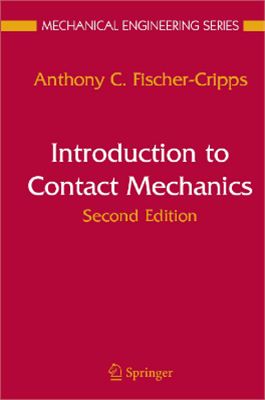2nd edition, Springer Science+Business Media, 2007, 221 pages
This book deals with the mechanics of solid bodies in contact, a subject intimately connected with such topics as fracture, hardness, and elasticity. Coverage begins with an introduction to the mechanical properties of materials, general fracture mechanics, and the fracture of brittle solids. It then provides a detailed description of indentation stress fields for both elastic and elastic-plastic contact. In addition, the book discusses the formation of Hertzian cone cracks in brittle materials, subsurface damage in ductile materials, and the meaning of hardness. Coverage concludes with an overview of practical methods of indentation testing.
Introduction to Contact Mechanics, Second Edition is a gentle introduction to the mechanics of solid bodies in contact for graduate students, post doctoral individuals, and the beginning researcher.
This second edition maintains the introductory character of the first with a focus on materials science as distinct from straight solid mechanics theory. Every chapter has been updated to make the book easier to read and more informative. A new chapter on depth sensing indentation has been added, and the contents of the other chapters have been completely overhauled with added figures, formulae and explanations.
The author begins with an introduction to the mechanical properties of materials, general fracture mechanics and the fracture of brittle solids. This is followed by a detailed description of indentation stress fields for both elastic and elastic-plastic contact. The discussion then tus to the formation of Hertzian cone cracks in brittle materials, subsurface damage in ductile materials, and the meaning of hardness. The author concludes with an overview of practical methods of indentation.
This book deals with the mechanics of solid bodies in contact, a subject intimately connected with such topics as fracture, hardness, and elasticity. Coverage begins with an introduction to the mechanical properties of materials, general fracture mechanics, and the fracture of brittle solids. It then provides a detailed description of indentation stress fields for both elastic and elastic-plastic contact. In addition, the book discusses the formation of Hertzian cone cracks in brittle materials, subsurface damage in ductile materials, and the meaning of hardness. Coverage concludes with an overview of practical methods of indentation testing.
Introduction to Contact Mechanics, Second Edition is a gentle introduction to the mechanics of solid bodies in contact for graduate students, post doctoral individuals, and the beginning researcher.
This second edition maintains the introductory character of the first with a focus on materials science as distinct from straight solid mechanics theory. Every chapter has been updated to make the book easier to read and more informative. A new chapter on depth sensing indentation has been added, and the contents of the other chapters have been completely overhauled with added figures, formulae and explanations.
The author begins with an introduction to the mechanical properties of materials, general fracture mechanics and the fracture of brittle solids. This is followed by a detailed description of indentation stress fields for both elastic and elastic-plastic contact. The discussion then tus to the formation of Hertzian cone cracks in brittle materials, subsurface damage in ductile materials, and the meaning of hardness. The author concludes with an overview of practical methods of indentation.

